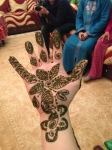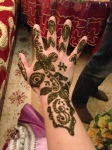It’s been such a whirlwind since leaving Rabat I don’t really know where to start. This is a long one…
After a 3 hour bus ride from Rabat to Fes, where we left half of our luggage, my cohort (Zack, Julie, Anna, Josh, me and our Language and Cultural Facilitator, Jawad) piled into a “Grand Taxi” for the 15 minute drive to Merja, an outer neighborhood of Fes. Lest the name “Grand Taxi” lead you to believe this was a vehicle large enough to hold 6 passengers, a driver, and the luggage of five people who had packed for two years, let me disabuse you of that notion. It was your average mid-sized sedan from the late ‘80s/early ‘90s. We were crammed in like sardines with three people in front, four in back, lots of luggage on laps and a trunk that was held shut with some kind of strap.
Amazingly we didn’t lose anyone or anything along the way and when we got to Merja there was a whole group of people waiting for us. After many formal introductions, “Salams” and cheek kisses (between ladies), and the official welcome from the head of the community, we were finally on our way to live with our host families who speak very little, if any, English. My family consists of host mother Raja, (who is 10 years younger than me BTW) her husband and two sons, ages 5 and 10. I admit to a pang of a kind of homesickness when seeing the older son, Ashref, who looks so grown up. That is how old my own nephew will be when I return home if I last the full two years! Zachariah, the 5 year old, was anxious to tell me all kinds of words. I did manage to remember spoon (melk-a), plate (top-seal) and glass (kess) before my brain was full. Truth be told, I ignored some of the words that Zachariah wanted to tell me. Teepee? I have limited bandwidth and I bet that the dwellings of the American Plains Indians are not going to come up in conversation over the next two years. I know, it’s a roll of the dice.
When walking to our site, one of the members of my cohort said “this is the craziest thing I’ve ever done” and I will second that.
My first meal was a kind of afternoon tea which is served around 6:00 and consists of sweet and salty snacks, tea and hot milk (with or without Nescafe, with or without sugar but I bet I’m the only one who drinks it without. Moroccans LOVE sugar and have a national diabetes problem). Zachariah has a workbook that helps him learn French and Raja’s sister Hayett, who is hosting another one of our cohort, used it to show us pictures of the different meals and their corresponding times. The workbook showed 8pm for dinner but Hayett indicated it was more like 9:00.
Alas (for this early to bed/early-to-mid-morning to rise old lady), it was a hair past 10:00 when the tagine came out. It was yummy, but I was exhausted. I had learned at tea that the key to eating is to leave some food on your plate. Members of the clean plate club will have more food immediately spooned back onto it. If you don’t have a plate, don’t finish your bread. Since you eat tagines out of a communal plate with a hunk of bread, finishing your bread is like cleaning your plate. DON’T DO IT!
When I met up with the cohort the next day and we all compared notes, all but one of us had been surprised and delighted that the bathrooms were way more western than what we had been led to expect. But we have all learned that many of the buildings are cold–much colder than the outside. I can usually see my breath inside and I am grateful for every layer I have. The area we are in is really interesting and I think not what one thinks of when one thinks of Morocco as a tourist destination (ancient medinas, intricately decorated mosques and medresas, camels) or of the Peace Corps in general (mud huts, no electricity).
To my American eyes, and in the late afternoon, it looks a bit like a half-abandoned suburban housing development. A lot of apartment buildings built on the same general designs, stray dogs, vacant lots, piles of trash, intermittent sidewalks and some streets that aren’t paved. But on closer inspection you are definitely not in America. Not only do you see lots of headscarves and jeballas (the robes that men wear over their clothes that make them look like very tall Jawas or maybe Jedi Knights) and some flocks of sheep in the vacant lot, but when it’s “business hours” (just what those are is hard to discern), you see what looked to your American eyes like garages on the ground floor are actually store fronts on nearly every apartment building’s ground floor. Coffee shops, bakeries, car washes, clothing stores, kwiki marts—everything you need within walking distance. Definitely not an American suburb.



But the infrastructure to provide things we take for granted in the US—road repair, animal control, trash pickup—just doesn’t exist here. (Of course there are those who think it shouldn’t exist in the US either. Welcome to the Tea Party dystopia!) As near as I can tell, Merja is a growing community, but they don’t put up pre-fab communities in the same way we do in the U.S. So there are lots of buildings in progress, some already occupied. So far I have seen a lot of the community but I have a hard time knowing my way around because there are no street signs and because many of the buildings look alike, especially when the stores are closed and the “garage doors” are covering the storefronts, aka my landmarks.
I kind of can’t believe I’ve only been here since Thursday night. On Friday we had a bit of language class followed by orientation to the community. But orientation was cut short due to weather (lots of rain) and the ill-health of our LCF, who has a bad cold. Fortunately the community is watching out for us/watching us. When we were walking around in the rain from apartment to apartment, meeting everyone’s relatives and being given tea and sugary snacks at every stop, a police van drove by to give us a ride. My first ride in a paddy wagon and it’s in Morocco! Somewhere along the way we were all invited to a wedding on Saturday night. Our LCF jumped at the chance to take a day off and recuperate while assigning us “homework” for the wedding.
On Saturday night I dressed up as much as possible given my limited wardrobe. My family took one look at me and started digging through their clothes for something more suitable. Soon I was decked out in a silver and black sequined “lipsa” (a kind of caftan but with two pieces) and a giant silver belt. Any hopes I had of relying on caftans to disguise how much sugar I am eating were dashed by that belt.
An Islamic wedding is marked by two critical differences from US weddings—no alcohol and the sexes aren’t supposed to mix. When we entered the bride’s parents’ house the boys were sent upstairs and the girls went downstairs. The house was amazing—two floors of intricate tile work and amazingly decorated ceilings. There were some women who weren’t dressed up at all—just jeans and shirts—but those who were done up were seriously done up. Lots wore headscarves arranged in such a way that there was a certain Carmen Miranda look going on. Some wore no scarf but had their hair decorated with lovely pins and barrettes.
I was glad I’d been appropriately dressed by my host family. After a lot of greetings were exchanged, we sat around until dinner was served. Bread and giant platters of chicken, followed by bread and giant platters of lamb. Woe is the person (me) who ate their fill on the chicken because they didn’t expect the lamb. To drink we had water, orange pop or Coke. After we had eaten, we headed upstairs to actually see the bride. At this point the rules started to relax a bit. There was still very clearly a male and female section, but the sexes did mix here and there (mostly men coming into the women’s section, not vice versa) and I even saw some mixed dancing. One woman who spoke English was really friendly and helpful to us as we tried to understand what was going on. Our LCF told us we’d probably be at the wedding for 3-4 hours. Three hours in, she told us that the wedding would go on until morning, although not everyone would stay that long. She then told us that the bride had a whole bunch of different outfits to wear, depending on how much money her family had and this was a very rich family. She herself had had 7 outfits at her wedding but she thought there would be more at this wedding.

With every outfit change there was a whole set of pictures taken with miscellaneous guests and relatives and another round of dancing. We arrived at 7:30, ate around 8:30, and then stayed through white, green and purple outfits (we were exhausted after the first outfit!) before finally piling into a taxi again around 1:00 am.
Today is Sunday which is supposed to be my only day off every week. I kind of had Saturday off too because Jawad was sick, but man that wedding was a lot of work! My goals for today: figure out how to ask to take a shower (4 days and counting!) and how to ask to do laundry.
Also, to find a cyber café which, if you are reading this, I have accomplished. A note about my internet access, I don’t seem to be able to find a place that has wifi. My only option is to go to “a cyber” and use their computers. The keyboards are in French and Arabic so it is confusing. So right now I can’t use facetime but I can skype. Maybe I will get into a rhythm but if not, regular contact with me will be on a pretty irregular basis.

 . All-linen outfits are great for high temps but the pink skirt, pale blue shirt and mint green jacket combo I rocked for much of July made me look like an Easter egg, albeit an Easter egg with her sexy, sexy ass appropriately covered.
. All-linen outfits are great for high temps but the pink skirt, pale blue shirt and mint green jacket combo I rocked for much of July made me look like an Easter egg, albeit an Easter egg with her sexy, sexy ass appropriately covered.













 , chill beach town. Chill as in mellow and as in not 100 degrees all the time. Only one of those things is currently true about my hometown here in Morocco.
, chill beach town. Chill as in mellow and as in not 100 degrees all the time. Only one of those things is currently true about my hometown here in Morocco.



























 of them wear a layer of lace fabric, tied on one shoulder like a toga, over whatever they are wearing. My neighbor ladies told me that it’s really just a thing here in N’Kob and the neighboring villages, not elsewhere in the south.
of them wear a layer of lace fabric, tied on one shoulder like a toga, over whatever they are wearing. My neighbor ladies told me that it’s really just a thing here in N’Kob and the neighboring villages, not elsewhere in the south. CBT I originally assumed that I would keep my hair tied back to be respectfully conservative-looking without actually wearing a headscarf. But it pretty quickly seemed unimportant and I let my hair down (literally) more often than not. I feel differently here in the south and would never walk around with my hair blowing in the wind. So I always have it up in a ponytail or a bun. Which is probably for the best because it disguises how desperately I am in need of a cut and color. Here’s a picture that a student drew of me with my ponytail. I am supposedly standing next to a donkey. I’ll leave it up to you to figure out if I have grown to towering heights or if the artist needs to work on mastering perspective.
CBT I originally assumed that I would keep my hair tied back to be respectfully conservative-looking without actually wearing a headscarf. But it pretty quickly seemed unimportant and I let my hair down (literally) more often than not. I feel differently here in the south and would never walk around with my hair blowing in the wind. So I always have it up in a ponytail or a bun. Which is probably for the best because it disguises how desperately I am in need of a cut and color. Here’s a picture that a student drew of me with my ponytail. I am supposedly standing next to a donkey. I’ll leave it up to you to figure out if I have grown to towering heights or if the artist needs to work on mastering perspective.
 See how comfy that nightgown thing looks? And see the guy on the curb and how he’s showing all kinds of leg?
See how comfy that nightgown thing looks? And see the guy on the curb and how he’s showing all kinds of leg? afield, like to the souk one suburb over (still walking distance though), it was time for jeans and a sweater.
afield, like to the souk one suburb over (still walking distance though), it was time for jeans and a sweater.

 differ from those in America. And I’m not sure how to best talk about the looming subject in everyone’s mind when we talk about clothing in Islamic countries–the headscarf. I know that it’s a very sensitive subject and there’s a lot of differing opinion about it. But let’s just get it over with. Let’s talk about the headscarf, commonly referred to as the Hijab—easy to wrap around one’s head but difficult to wrap one’s head around. See what I did there? Hilarious.
differ from those in America. And I’m not sure how to best talk about the looming subject in everyone’s mind when we talk about clothing in Islamic countries–the headscarf. I know that it’s a very sensitive subject and there’s a lot of differing opinion about it. But let’s just get it over with. Let’s talk about the headscarf, commonly referred to as the Hijab—easy to wrap around one’s head but difficult to wrap one’s head around. See what I did there? Hilarious. fight. All I expect to do here in Morocco is be a woman who doesn’t wear one and let people take that as they will.
fight. All I expect to do here in Morocco is be a woman who doesn’t wear one and let people take that as they will. keep it in place. The same effect can be achieved with some expert folding and tucking but pins assure it stays put. With this scarf, the neck is usually covered as well. My host mom in Merja would swap casual tied scarf for pinned scarf on special occasions such as my going away party and a trip to Marjane (the Moroccan Wal-Mart). For things like weddings and birth ceremonies, sometimes women pin their scarves into very elaborate and decorative flower-like shapes.
keep it in place. The same effect can be achieved with some expert folding and tucking but pins assure it stays put. With this scarf, the neck is usually covered as well. My host mom in Merja would swap casual tied scarf for pinned scarf on special occasions such as my going away party and a trip to Marjane (the Moroccan Wal-Mart). For things like weddings and birth ceremonies, sometimes women pin their scarves into very elaborate and decorative flower-like shapes.












